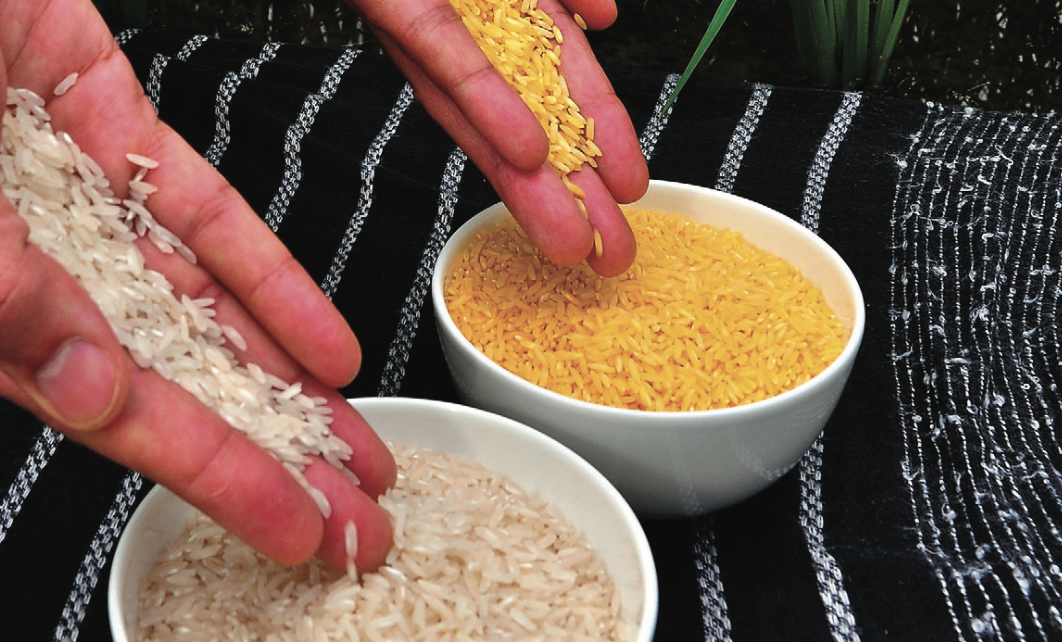Please note the Addendum from April 4th, 2023 at the very end of the article!
An interview with Ingo Potrykus, one of the inventors of Golden Rice
In 1992, Ingo Potrykus together with Peter Beyer, started to develop “Golden Rice,” a variant enriched with the vitamin A precursor ß-carotene to help alleviate malnutrition, especially in Asia. The road from the first “golden grains” to the first harvest in 2022 was rocky. Ingo Potrykus kindly agreed to answer the many questions of the BioWissKomm team (Hanna Willenbockel, Jann Buttlar and Wolfgang Nellen) patiently and in detail.
The interview was conducted by e-mail correspondence.
Background information on Golden Rice is provided in this blog article.
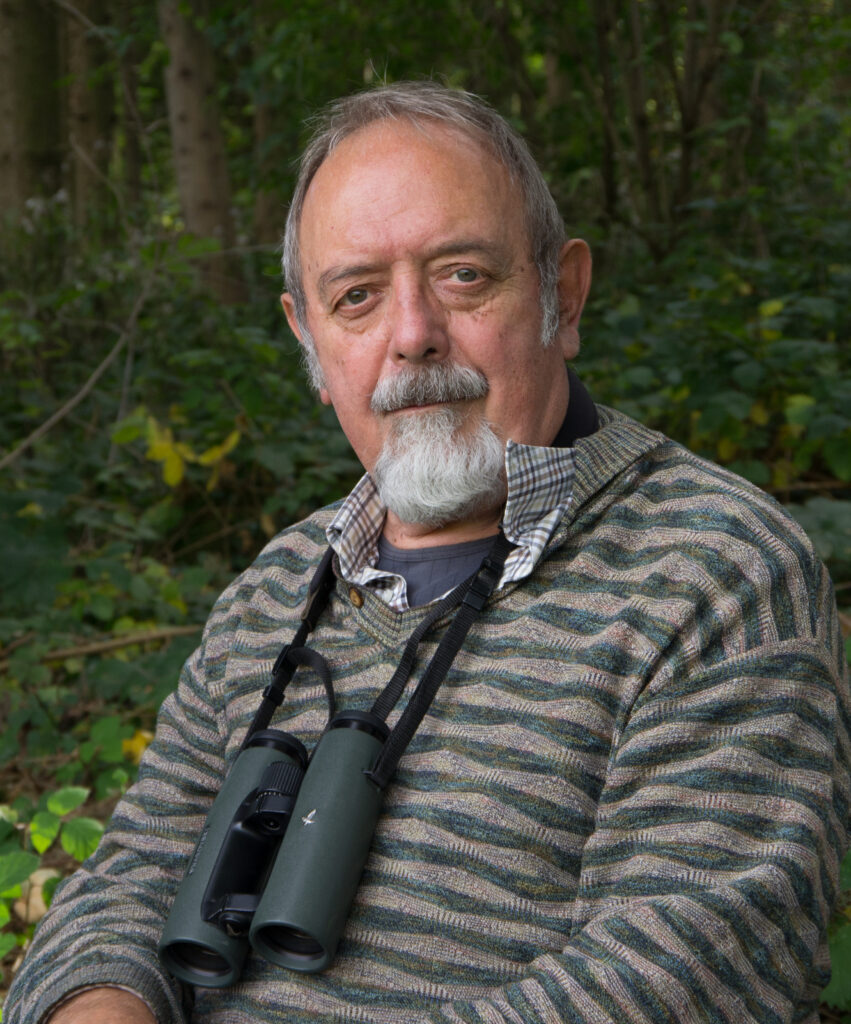
BioWissKomm: You didn’t necessarily follow a classic career path. You were a high school teacher before you switched to science. Was that an easy decision for you back then? What advice would you give to young students today when they have to decide what to do with their biology degree?
Potrykus: The decision to switch from teaching to science was not easy because I had the responsibility for a family with two children and I had to give up my tenured position for an uncertain future.
I don’t think I can advise anything. The situation is so different today.
BioWissKomm: Why did you choose biology of all things? After all, you could have done humanitarian work in many other disciplines as well.
Potrykus: I have been a biologist since my youth. I was and still am a “rubber-boot-biologist” and conservationist (see e.g.: www.birdphoto-potrykus.ch). I didn’t have to “decide”, I just was a biologist. I came to genetic engineering late and only as a means to an end. Genetic engineering was always only part of my interest, even though I was one of the pioneers of its development. However, there is no doubt that genetic engineering has helped me make my most important contributions to mankind.
BioWissKomm: In the article in “Republik” you say that science gets “lost in basic research”. What do you think young scientists (and students) should focus on? Does research need more focus on applications?
Potrykus: We need both – basic research and the application of its results.
Students can indeed decide whether they want to join a research group that focuses more on the basics or more on applications. But what they can ultimately do depends on what their supervisors get funded for. The same applies for professors. Even if they are interested in applications, they can only do limited work at best. The academic research system doesn’t fund applications. Our research funding is on “basic research.” Applications are left to industry. Industry works on projects that promise financial gain. Humanitarian projects do not fall into this category. Thus, humanitarian projects fall through all funding cracks. Unfortunately, many professors spend time doing financially interesting research for industry. The public money does not fund research in the “public interest,” such as humanitarian projects like Golden Rice, which can alleviate the plight of the poor. That task is shifted over to humanitarian foundations, such as the Bill & Melinda Gates Foundation.
BioWissKomm: How do you see the chances for young German/European plant scientists? Will Golden Rice bring a breakthrough to acceptance or is it more advisable to do research and development in other countries? Not everyone has the endurance or “stubborness” like you!
Potrykus: No, I don’t see many opportunities for young scientists. Not only in Germany, but worldwide.
I could afford my “endurance” in research because I was in the privileged situation of an ETH professor who had enough independent funding to tackle such a risky project. And was working at an institute where, thanks to the foresight of Nobel Prize winner Professor Werner Arber, three professorships for basic research and six professorships for applied research were combined – in the Institute of Plant Sciences at ETH Zurich.
Even the professorships for applied research could only do “basic research for application” with the available funds. For the “bigger chunk”, the development of a “GMO product of the deregulated variety”, we were left completely alone. However, the development of a “product” was imperative. Only with a “product” can you help people. Hunger and diseases are not reduces by research data alone.
The “public authorities” had neither the interest nor the finances to tackle such a humanitarian project. The WHO, for example, which has the UN mandate and funds to fight vitamin A deficiency, stubbornly refused to support us until today. Why? The answer is as outrageous as it is simple: the major UN donor countries are against GMOs. Yes, we Europeans, with our hysterical attitude toward genetic engineering, are blocking the use of life-saving technology.
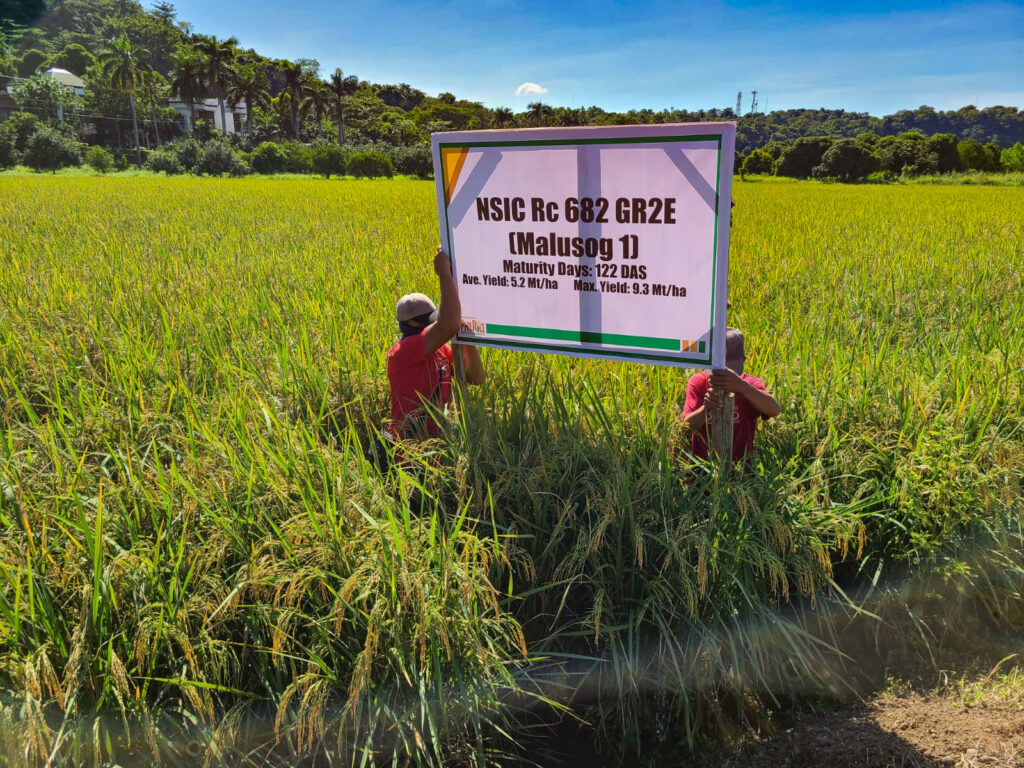
BioWissKomm: One criticism of “green genetechnology” is that it is often used in monocultures, in conventional agriculture with lots of pesticides. Do you see the possibility of combining genetic engineering with organic farming (as the environmental ethicist Konrad Ott suggested almost 20 years ago)? What has prevented this so far?
Potrykus: Organic farming also uses monocultures. Pesticides are not fundamentally “bad.” In “integrated farming” (in my opinion the preferred type of farming), they are used in an optimized way according to the damage threshold principle: only when necessary and only as much as necessary.
The cooperation between organic farming and genetic engineering fails mainly because of the ideological rejection from the side of organic farming. There have been many offers from the genetic engineering side for joint projects. The label “without genetic engineering” has meanwhile become an ideological “seal of quality”: people buy a supposedly good conscience as a bonus.
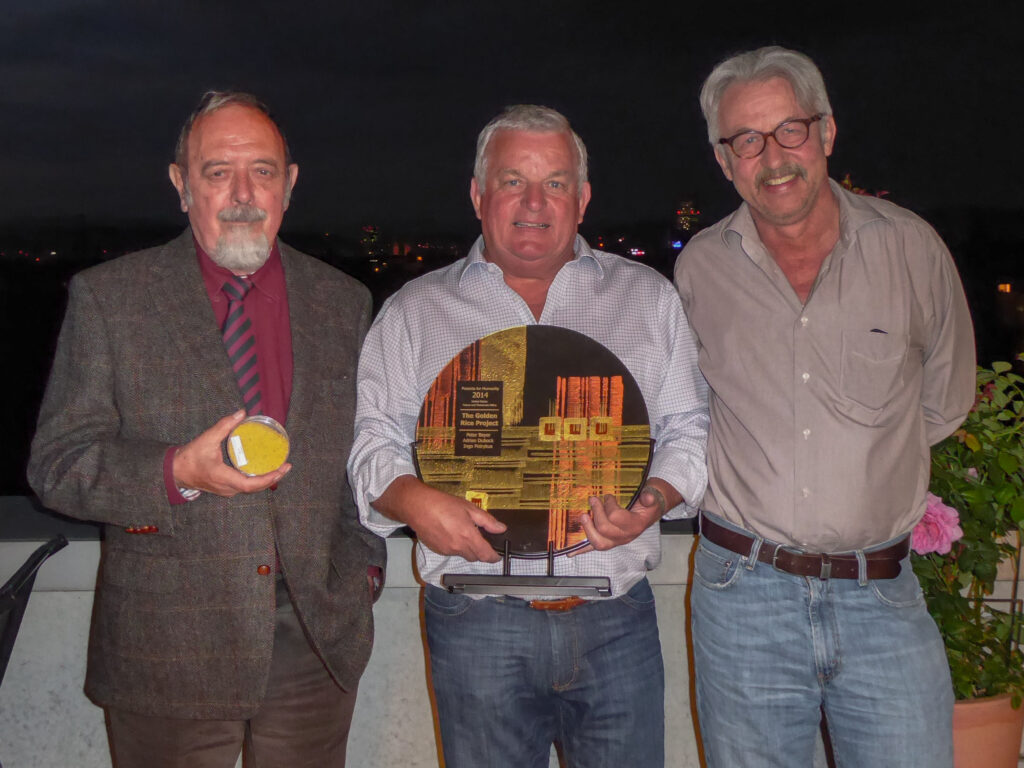
BioWissKomm: The public relations work for the acceptance of Golden Rice, also by the Golden Rice Humanitarian Board, was of limited effectiveness. It was often referred to as the “Trojan Horse of genetic engineering” and even the patent-free status and free distribution of the seeds did not do much to change the negative campaigns. Similarly, support by scientists such as Urs Niggli, the American couple Pamela Ronald and Raoul Adamchak and Sir Richard Roberts, as well as other numerous Nobel laureates had limited success. What was the reason for this?
Potrykus: Greenpeace only does public relations work with millions of euros. We had no resources for PR. In the first place, we had to do the lab work! Nevertheless, my group and I have always represented GMO technology in public, including protest marches in the streets.
Regarding the case of the public letter from 158 Nobel laureates and thousands of professional colleagues to Greenpeace: their response is unsurpassed in stupidity and arrogance: “They don’t know anything about it!”
None of the members of Greenpeace’s highly paid governing body has ever done any serious experimental science! They may not know anything, but they “know everything better.” It’s as simple as that with an “ideology.” When one of the last Greenpeace chiefs dared to suggest discussing Golden Rice in an open-minded way, he was fired.
Monsanto was a stroke of luck for Greenpeace. When they succeeded in linking genetic engineering with Monsanto, “it was all over”. Genetic engineering equals Monsanto! For public opinion this was the worst thing imaginable! From then on, the technology was discredited, no matter what was done with it. The term genetic engineering triggers defensive reflexes and prevents any objective discussion.
BioWissKomm: It will take a few more years before the success of Golden Rice in combating malnutrition can be statistically proven. Such a practical success could result in loss of credibility for the organizations that have fought it for many years.
Do you expect a new wave of campaigns to undermine public acceptance of Golden Rice?
Potrykus: Yes.
BioWissKomm: This is a very short and very scary answer!
BioWissKomm: Meanwhile, there are more and more scientists who are working in various initiatives and projects for a productive science dialogue. For example, the association Öko-progressives Netzwerk e.V. or established institutions like the “Gläserne Labor” in Berlin, which do good public relations work – and BioWissKomm is also trying to make a small contribution. Overall, however, there is a great deal of skepticism among the general public about green genetic engineering and thus also about Golden Rice. In order to give the general public a better, realistic insight into science, to rationalize unrealistic fears, and to generally facilitate a good dialog about genetic engineering – what would be your wishes …
… for scientific institutions?
Potrykus: Explain to the public, using attractive examples (without exaggerating), what benefit society gets from science. There needs to be many more science journalists with experimental experience.
BioWissKomm: … for politicians?
Potrykus: Listen to internationally recognized scientists (e.g. via the academies) and do not run after the charlatans of pseudoscience. Very difficult to implement, as hardly any politicians know from their own experience what “science” is.
BioWissKomm: … for young plant scientists (whose future is at stake, after all!)?
Potrykus: working with genetic engineering is “scorched earth” in Germany and Europe.
BioWissKomm: … for the general public?
Potrykus: No comment
BioWissKomm: There were problems with the development of Golden Rice, as with any scientific project: in the first version, the ß-carotene content was much too low.
Potrykus: Wrong, although according to the published facts this is true. Our first prototype had 1.6 micrograms/gram of provitamin A in the heterozygous state. Golden Rice grown in the Philippines today has 4-5 micrograms. According to the chief rice breeder of IRRI, Gurdev Khush, it would have been easy to close this gap in a few backcrosses.
BioWissKomm: In a later version, a “wrong” event, (a genetically modified variant) was selected, which produced suboptimal yields.
Potrykus: True, but why? Plant breeding reads “correct events” by examining thousands of individuals for their response to climatic and agronomic conditions in the field. GMO regulations strictly prohibit bringing GMOs into the field before they are deregulated (i.e. approved). Now try to test the response of thousands of plants to different agronomic and environmental conditions in a climate chamber! Impossible! The GMO regulations made any reasonable work impossible for many years.
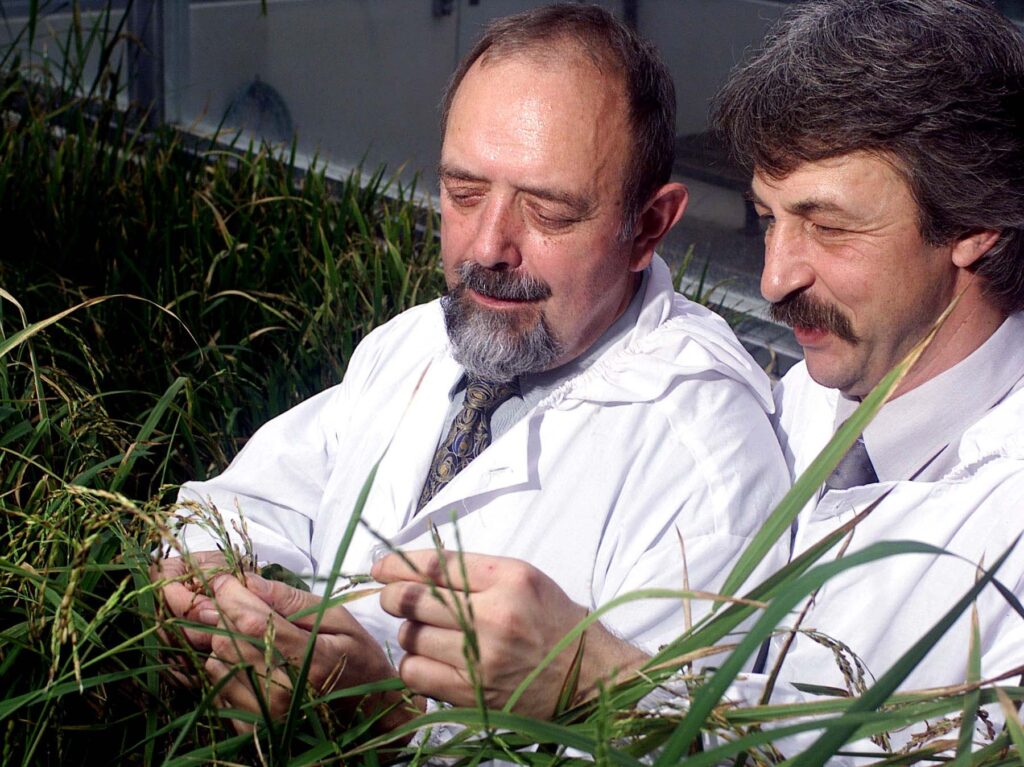
(Photo: Ariel Javellana, IRRI)
BioWissKomm: In science, such setbacks are routine – you go back to the lab, look for the errors and work on optimization.
Potrykus: These were not routine setbacks. Detours made unavoidable by the GMO rules. Yes, the thought is correct, but our problems were 99% due to the GMO rules.
BioWissKomm: In a project with such public attention, setbacks were interpreted as “failure”. What do science and science communication have to do to generate more public understanding/insight into scientific working methods?
Potrykus: See above: more science journalists and more money for editorial offices so they can hire competent science journalists. And for all media: more political balance among media professionals. There is a political bias and this is unhealthy for democracy. In general, I see a main problem in the media. Fact-based and informative articles that leave room for own interpretation are in the minority. Opinion instead of information is not journalism for me.
BioWissKomm: It seems that a change in thinking is slowly taking place among young people and also among the Greens (for example, triggered by Hauke Köhn in Lower Saxony and Dorothea Kaufmann in Rhineland-Palatinate). Do you think this will catch on?
Potrykus: That’s very good, but I’m not optimistic.
BioWissKomm: In Germany, the EU and around the world, there are many research projects on GMO plants that, for example, need fewer pesticides and fertilizers and are supposed to be better adapted to climate change. In some cases, these plants have cisgenetic modifications (genetic modifications that come from old, more original varieties) that make them even closer to their evolutionarily more original form. Is that going to be the future? Do you see an opportunity for this in Germany?
Potrykus: The cisgenetic concept is an opportunistic reaction to the claim by opponents of genetic engineering that “foreign” DNA poses an incalculable risk. There is no such thing as “foreign” DNA. The DNA of all organisms is an evolutionary continuum and all organisms naturally contain substantial amounts of DNA from other systematic categories. Evolution has always used the incorporation of DNA as a vehicle for progress. The expression “foreign DNA” is nothing but an efficient propaganda tool of the opponents of genetic engineering.
BioWissKomm: The concept of Golden Rice, namely to enrich staple crops with vitamins and other important ingredients, has gained acceptance in the scientific community: there are already genetically optimized cassava and millet, for example. Other crops are in the works or already in field trials. Where do you see the greatest need for the future of world nutrition? What projects would you tackle today (assuming that the vitamin A problem has been solved)?
Potrykus: It was the Golden Rice Project that initiated the concept of “biofortification” – improving the micronutrient content of crops. The success of that project led the Gates Foundation to invest heavily in the biofortification approach – including non-GMO projects. (btw: my lab was one of the pioneers of Cassava biotechnology).
Yield enhancement and yield protection is where the industry continues to invest. And this will continue as long as food quality is not rewarded by higher prices. That’s why I would continue to work in the area of “micronutrients,” with the goal of increasing the content in staple foods (especially grains) in terms of vitamins, minerals, and essential amino acids – all at the same time in the same plant! We have already published on rice with increased iron content in the same year that the publication on vitamin A rice appeared. Currently IRRI (International Rice Research Institute) is working on a vitamin A / iron / zinc – rice (iron and zinc anemia are huge problems). This concept of optimizing as many micronutrients as possible in the same plant would obviously need to be extended to as many staple crops as possible. This requires cooperation between genetic engineering and plant breeding.
BioWissKomm: Many people have no idea how slow or fast certain processes are.
How long would Golden Rice (in its current version) have taken to get to the field without the “opposition”?
Potrykus: According to the chief rice breeder at IRRI, three years or eight backcross generations. If Golden Rice had not been a GMO, it would have been used since 2003 and would have saved millions of children from blindness and death over the nearly 20 years.
BioWissKomm: How long would it have taken with conventional crossing methods?
Potrykus: Infinitely. Can’t be done. Rice breeders have tried everything in vain to achieve this goal and have therefore turned to genetic engineering for help. Our project was the answer to this call for help.
BioWissKomm: How long would it have taken with the “new genetic engineering” CRISPR-Cas?
Potrykus: Just as long as with “conventional” genetic engineering, because CRISPR could only do it with genetic engineering. A CRISPR-Golden Rice would have to overcome all the regulatory GMO hurdles that we have overcome. It would not bring any advantage.
BioWissKomm: We should explain that briefly: even with CRISPR, Golden Rice would have required introduction of “foreign DNA.” Even after reforming EU gene-tech laws, the product would be subject to the same strict regulation as conventional genetic engineering.
Potrykus: I warn against the hype and confusion around CRISPR. CRISPR is an efficient technique for obtaining mutations. CRISPR is “sold” as a technique that does not alter the genome. And the claim to be exempt from GMO regulations is based on this. CRISPR has advantages in terms of “loss-of-function” projects, i.e., knocking out specific gene functions. However, CRISPR has great difficulty in “gain-of-function” projects, where additional functions are to be inserted. I observe the curious situation to use CRISPR for quite normal genetic engineering (just replacing Agrobacterium with CRISPR) and then wonder why the regulatory authorities regulate – it as genetic engineering when you transfer “foreign DNA” with CRISPR! Too bad that the number of attractive loss-of-function projects is very limited. Gene editing can complement genetic engineering. Gain-of-function projects, such as Golden Rice will only work (except for some complicated exceptions) with the help of genetic engineering.
Additionally: has anyone ever thought about what this means in terms of patent limitations? The Agrobacterium patents have practically all expired. With CRISPR, we are at the beginning of a decades-long, complicated patent dispute. A horror for the application.
BioWissKomm: Finally, a rather philosophical question: With terms like “nature” and “naturalness” one usually associates something good, something worth protecting. Genes are “natural”, as are genetic changes by mutations – otherwise there would be no evolution. On the other hand, the term “gene technology” contains the word “technology”, which many people associate with placing oneself above nature with a “technology”, which is often interpreted as bad or arrogant. What do the terms “naturalness” and “technology” mean to you. Is man still part of nature at all?
Potrykus: Yes, of course, the “dear Mother Earth – Gaia”. “Nature” is neither “dear” nor “kind”. It ignores every moral category. Nature is indifferent, indifferent and consequently follows her laws. Thereby she often appears “cruel” and “unjust”.
Only by using these laws to our advantage – developing techniques – we can survive. I do not argue for excessive exploitation of nature! Man has a moral responsibility. He is obliged to deal with nature in moderation. But our technologies help us to do this. As a biological being, man cannot help but be part of nature. Many people have a completely wrong idea of nature. For example, in its “natural” state, Germany was almost entirely covered by forest, with few tree species and a much lower “biodiversity” than today. What is perceived and transfigured as “natural” in the landscape of pre-industrial times was and is “cultural achievement” of man. This nature has always been in a constant state of change. Technology enabled us to create this cultural achievement. Technology is not our enemy, it is our friend. We should be careful not to fix romanticized “nature” of the last century as a museum. Back then, the majority had to work hard for our food; today, we get it as a gift from a very small minority – thanks to the development of technology in all sectors of agriculture. The vast majority of the population has no idea about agriculture, but thinks it is entitled to constantly dictate how to do it to those who practice farming professionally with experience and success. This discrepancy between ignorance and entitlement – not only in the area of food security but in general – seems to be one of the fundamental causes of Germany’s decline.
BioWissKomm: Ingo Potrykus, we thank you very much for the interview and hope with you that Golden Rice will soon be in the hands of the farmers who need it!

Title photo: White rice and golden rice (Photo: IRRI)
Addendum on April 27th, 2023
The Supreme Court in Manila has ruled that the cultivation of Golden Rice (and Bt-Brinjal) will be stopped. This invalidates the interview’s cautiously optimistic view. When asked if he expected further action by NGOs against Golden Rice, Potrykus had answered with a simple “yes.” This is now confirmed.
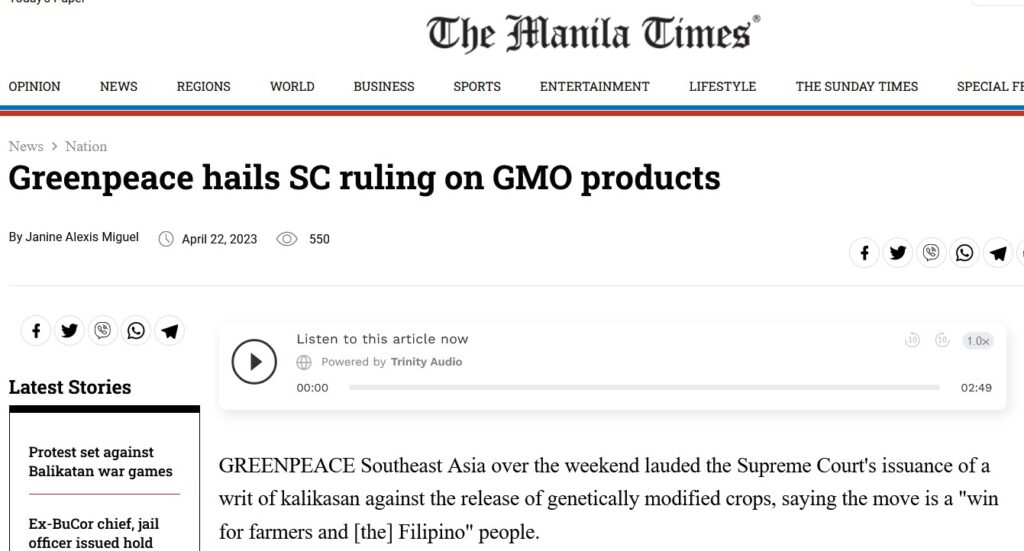
The worldwide consortium of powerful anti-GMO organizations has once again succeeded in influencing national jurisdiction. Consequently, Greenpeace praises the “win for Philippine farmers”. The “win” is likely to be several 100,000 victims due to malnutrition. The NGOs are unlikely to take responsibility for this.
The simultaneous ban on the cultivation of Bt-Brinjal (eggplant) will also cause fatalities: in Bangladesh, Bt-Brinjal has been cultivated since 2014. The results of the evaluation are shown in the graph.
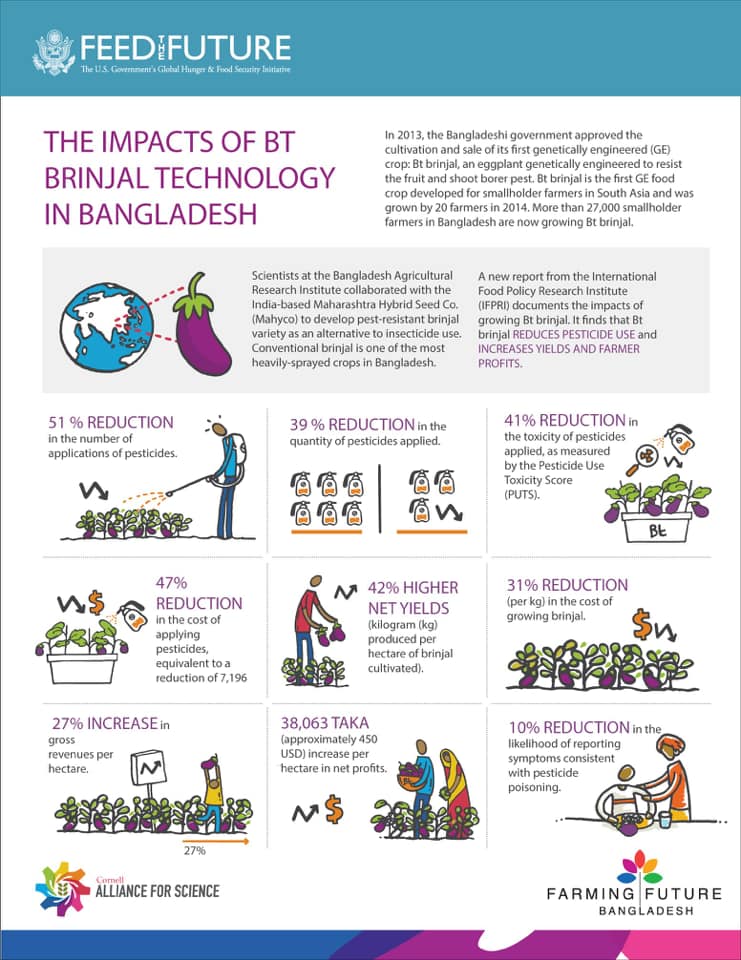
Interesting: in India, Bt-Brinjal is now banned again. However, smallholders are helping themselves: a flourishing black market with Bt seeds has emerged on the border to Bangladesh. This is not without danger because these seeds are mostly not controlled and certified. Fraud with fake seeds or contamination with non-Bt seeds can lead to major crop losses.
Translated with www.deepl.com , modified by BioWissKomm

